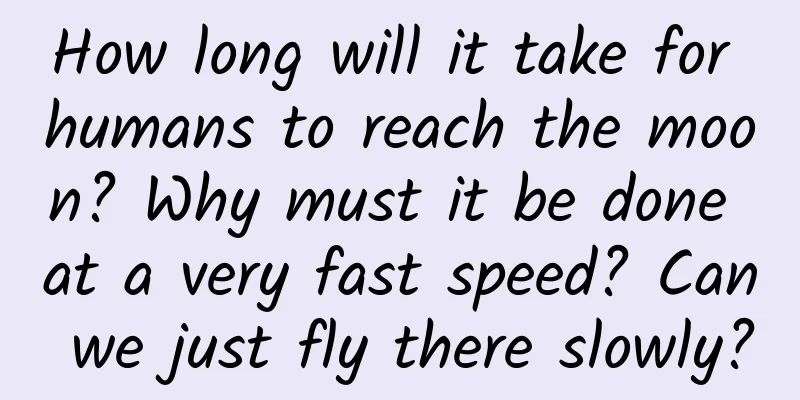How long will it take for humans to reach the moon? Why must it be done at a very fast speed? Can we just fly there slowly?

|
This article is based on answering a question from netizens: How long does it take for an adult to walk from the Earth to the Moon? This is a nonsense question. An adult can never walk out of the earth with two legs, so how can he walk to the moon? But if we understand it as the distance between the earth and the moon, how long does it take to walk such a long distance based on the walking speed of humans? This is a simple elementary school math problem. The average distance between the Earth and the Moon is 384,000 kilometers. An adult can walk about 4 kilometers per hour at a moderate speed. If we calculate based on working hours, walking for eight hours a day, that is 32 kilometers. This would take 12,110 days, about 365.25 days a year, or about 33.16 years. The walking time can be adjusted according to the actual situation, depending on how fast or slow a person walks and how long they walk each day. But what’s the point of doing such an elementary school math problem? If humans want to leave the Earth, they must first overcome the Earth's gravity. The way to overcome it is speed. The equipment currently used is mainly rockets. Depending on the destination, the rocket is generally required to reach one of the three cosmic speeds. What are the three cosmic speeds? These are the speeds that scientists have calculated based on the Earth's gravity to counteract gravity. The first cosmic velocity is 7.9 kilometers per second. When this speed is reached, it can counteract the gravity of the earth and revolve around the earth at a certain height. It will not be pulled down by the earth's gravity, nor will it escape from the earth's gravity and fly away. Therefore, it is also called the orbital velocity; the second cosmic velocity is 11.2 kilometers per second. When this speed is reached, it is possible to escape from the earth's gravity and fly to other planets. Therefore, it is also called the escape velocity; the third cosmic velocity is 16.7 kilometers per second. When this speed is reached, it is possible to escape from the sun's gravity at the earth's position and fly out of the solar system. Therefore, it is also called the escape velocity. There is also the fourth cosmic velocity, which is the speed of escaping from the Milky Way, but I won’t go into that here. In fact, the second cosmic velocity is the Earth's escape velocity, that is, the speed at which you can escape the Earth's gravity. Based on the Earth's position in the solar system and its relationship with the Sun and other planets in the solar system, we can calculate that the Earth's gravitational influence range (Hill sphere radius) is about 1.5 million kilometers. In other words, within this range, if you do not reach the second cosmic velocity, you will eventually be pulled back by the Earth. The moon is 384,000 kilometers away from the earth, so it is still within the earth's gravitational field, so the moon is pulled by the earth's gravity to revolve around itself. Therefore, if humans want to go to the moon, the speed must reach between the first cosmic speed and the second cosmic speed, generally reaching about 10 to 11 kilometers per second. Reaching the moon is not a straight line, because the Earth is rotating and revolving, and the moon is also revolving. In order to reach a higher speed, the spacecraft must orbit the Earth several times to increase to a predetermined speed. Therefore, the actual distance traveled by launching a spacecraft to the moon is far more than 384,000 kilometers. If the speed is 11.2 kilometers per second, it will take less than 10 hours to travel 384,000 kilometers. But in fact, all spacecrafts need to fly for several days to the moon. For example, the Apollo 11 manned lunar spacecraft was launched at 9:32 am on July 16, 1969, and did not reach the vicinity of the moon until July 19. It landed on the lunar surface at 8:17:43 pm on July 20. my country's Chang'e 5, launched on November 24, 2020, also took 4 days and reached the lunar orbit on November 28. The speed of a spacecraft launched to the moon can certainly be faster, even exceeding the third cosmic speed, but braking after reaching the moon will be more difficult, the braking distance will be longer, and more braking fuel will be consumed, which will not be worth the cost. Therefore, an appropriate speed is the most economical and efficient. The gravitational formula is: F=GMm/r^2, where F represents the magnitude of gravity, G represents the gravitational constant, M and m represent the masses of the two sides of the gravitational force, and r represents the distance between the centers of mass of the two sides of the gravitational force. From the gravitational formula, we can see that the magnitude of gravity is proportional to the mass and inversely proportional to the square of the distance. This means that the farther the distance, the faster the gravity decays. Therefore, the three cosmic velocities are the speeds that the Earth's surface needs to reach to leave the Earth. At the position of the moon, the speed required to escape the Earth's gravity is much smaller. According to the second cosmic velocity formula v=√(2GM/R), the speed "v" to escape the Earth's gravity at such a distance from the moon only needs to be a little over 1.44 kilometers per second. But if you get close to the moon, you will be pulled by the moon's gravity, and the moon's gravity on you is greater than the earth's. The escape velocity on the moon's surface is 2.37 kilometers per second, and the orbital speed must reach about 1.7 kilometers per second. Therefore, when you are near the moon, you need to have a speed of more than about 1.7 kilometers per second to avoid being pulled down by the moon, and a speed of more than 2.3 kilometers per second to escape the moon's gravity. The three cosmic velocities only refer to the initial speed on the surface of the earth that can counteract the earth's gravity. Many friends always don't understand this question, and often ask if there is always fuel to maintain the speed, can we not reach the three cosmic velocities and slowly escape the earth's gravity? My answer is: Of course you can. But the problem is that this requires a huge amount of fuel consumption, and the rocket or spacecraft needs to carry a sufficiently large amount of fuel; and the huge amount of fuel will greatly increase the rocket's takeoff weight, so more fuel will be needed for takeoff. The added fuel and equipment weight will form a vicious circle and it will be impossible to take off. Therefore, scientists have found that the calculated orbital velocity, separation velocity, and escape velocity are the initial velocities that need to be achieved for space launches so far, and are the most scientific and fuel-efficient launch method to counter the Earth's gravity. After the rocket reaches the initial velocity, it has already flown out of the atmosphere and has no air resistance, so only a small amount of fuel is needed to accelerate, decelerate, and change trajectory, relying mainly on inertia or the slingshot effect of celestial gravity to increase speed and fly to distant targets. After humans learned about the wonderful effects of gravity, they were able to use this known natural law to leave the earth and fly into deep space. If people don't use flying machines, no matter how much they jump, they can't jump more than a few meters high. How can they walk to the moon? Therefore, this article only uses this nonsensical question to simply popularize the scientific common sense between gravity and speed for your reference. Is this clear? Thanks for reading and welcome to discuss. The copyright of Space-Time Communication is original. Infringement and plagiarism are unethical behavior. Please understand and cooperate. |
<<: How did chili pepper and mint win the “Nobel Prize in Food”?
>>: How ferocious are wolves? Can an adult man holding an iron stick fight a wolf?
Recommend
Otters are not celebrity animals, so why do zoos have to keep them?
"Look, this is water lǎn!" "What i...
The underlying logic of community fission and private domain traffic
As the clock struck 24:00 on Double 11 Carnival N...
Why can’t user portraits be implemented?
User portraits , as an effective tool for outlini...
The "residents" of the rainforest are quietly changing
Produced by: Science Popularization China Author:...
4,000 meters deep in the sea! my country's first inter-oceanic ridge deep-sea electromagnetic joint exploration geological experiment was successful!
On September 5, the South China Sea Institute of ...
How to complain about false sales behavior in WeChat Mini Programs? Can I file a complaint about after-sales service for items purchased through the Mini Program?
As many businesses have opened their own WeChat m...
How do wind turbines generate electricity when their blades are so thin?
The weather is getting colder and colder, and the...
Can it make "Halo" shake? "DESTINY" PS4 version game experience
Since Bungie was acquired by Microsoft in 2000, &...
Exercise can help you lose weight, so why doesn’t doing housework count?
Since Rong Ge lost weight, many friends have come...
Is irradiated food related to radiation? Can we eat it safely?
As the saying goes, "food is the first neces...
The most complete and powerful analysis: Internal analysis of the Alipay wallet system architecture (architecture diagram)
Overview of Alipay System Architecture Typical pr...
Will OLED technology become the future trend of television?
Why OLED technology is suitable for TVs Since LCD...
Two ways and three tricks to follow the trend: How to follow the hot spots to make them explode?
I don’t know when it started, but people who work...
If you drink one less cup of coffee every day, you can drive this artificial intelligence car that can send emojis!
It can be seen that today's automobile indust...
What configuration is required for a gaming website hosting server?
There are very strict requirements for the config...









